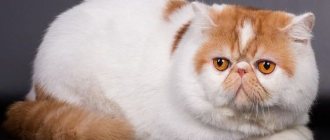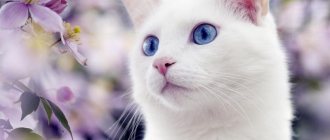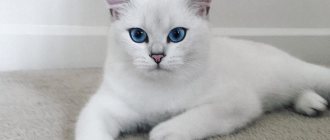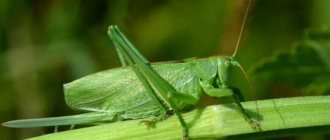Some cats have heterochromia iris, which is an unusual condition in which the iris of each eye is a different color. The result is a cat with one blue eye and the other green, yellow or brown.
Heterochromia can be genetic or acquired due to health problems. Three types of heterochromia: complete, sectoral and central. All kittens are born with blue eyes because they have no melanin in their irises. Heterochromia occurs when melanin fails to develop in one of the eyes, resulting in one eye being blue while the other matches the cat's actual eye color.
Although unusual eyes are a genetic defect, many owners and breeders view heterochromia as a trait that adds uniqueness to a cat. Cats with this condition often bring in more money than cats with normal colored eyes.
Genetics of the phenomenon
Heterochromacy is a phenomenon associated with different colors of the irises of the eyes. The cause of its occurrence is always a lack or excess of the melanin pigment in cats, and in albinos it is even completely absent.
This feature is much more common in cats than in humans. In this case, one eye is most often blue.
Variegation of eyes in cats is directly related to color and most often affects animals that have a lot of white in their color, although it also occurs in black cats. In this case, the second, non-blue eye can be yellow, green, or orange.
Cat heterochromacy can be easily explained from a genetic point of view.
The snowy coat gene has a strong effect not only on the color of the coat. During the development of the fetus in the womb, it also has a significant impact on the formation of the nervous system. It is its presence in the nerve endings of the eye that causes the absence of melanin there and forms the blue color of the iris. Both organs of vision or one may be affected.
This gene also affects hearing. After all, most white cats with blue eyes are deaf. And if the nerve endings on one side of the head are affected by it, then different eyes are observed, for example, blue and yellow irises, and unilateral hearing loss.
If the cat is completely white and both irises are blue, then this is the action of the dominant W gene. If it is homozygous, then the kittens die in the womb. Only heterozygous snow-white and blue-eyed individuals survive. In this case, White is combined with another “non-white” gene. Therefore, the entire litter is never born pure white; often there are spotted and even black babies.
How does it affect your pet's health?
As mentioned earlier, quite often, cats pay for the different color of the iris with hearing impairment, up to its complete loss. With an equal degree of probability, an animal may be deaf in one ear or both.
Single-sided deafness or significant hearing impairment in one ear and complete loss in the other are also possible. The phenomenon occurs if the cause of different-colored eyes is a genetic factor, which often disrupts the development of the hearing aid. But this is not a rule, and the animal may turn out to be full-fledged.
Deafness is not found in all cats with unusual appearance.
Because of this, before selling kittens, a conscientious breeder usually obtains a veterinary report on the condition of the animal. A kitten with partial or complete deafness costs less than a fully hearing one.
Types of odd eyes
According to the method of occurrence, heterochromacy in cats can be congenital or acquired.
According to the distribution of the iris of the eye, they are distinguished:
- full;
- sectoral;
- ring
Complete heterochromacy is when one iris of a cat is blue, and the other is any other color.
Sector discordance is determined by the fact that only some part of one or both irises is painted a different color.
Ring implies the presence on the iris of the eye of a kind of ring of a different color from the main color, usually along the edge.
Strange eyes and deafness
Deafness in white cats appears to be associated with the white spot gene and the dominant white gene. It is more common in cats with blue eyes or heterochromia. As experts explain, this is due to the fact that the white gene can sometimes cause degradation of the cochlea without disrupting the migration of melanocytes into one or both eyes. The cochlea is the part of the inner ear involved in hearing. This results in permanent deafness in one or both ears.
Multi-colored eyes can be found in completely different breeds. Heterochromia is a normal deviation because such cats are no different from the rest. If your cat with multi-colored eyes is deaf, with proper maintenance and care she will give you the same love and devotion as ordinary cats.
Is this a disease?
Congenital heterochromacy is not a disease and does not affect a cat’s visual acuity in any way. But it can affect your hearing.
But if we are talking about purebred animals, then such an individual is removed from the breeding program in order to minimize the possibility of the birth of deaf kittens and stop the spread of the defect in this species.
Acquired difference of eyes occurs due to injury, disease, inflammation, tumor.
There are two types of acquired heterochromacy:
- Abnormal darkening of the iris. It is caused by iron deposition (siderosis) and can also be triggered by the use of certain eye drops by stimulating melanin growth. These are, for example, drugs to reduce intraocular pressure, which are used to combat glaucoma.
- Abnormal lightening occurs due to atrophy of the iris due to inflammation, due to neuroblastoma, melanoma, uevitis, leukemia and some other pathologies.
What is heterochromia
Heterochromia is a phenomenon in which there is a difference in the color of the iris of the right and left eyes. This phenomenon exists in two variations:
- complete heterochromia - eyes of different colors;
- partial - segments of the iris of one of the eyes differ.
With partial heterochromia, one eye is colored two different colors
The phenomenon of heterochromia in representatives of the cat family is not uncommon. Such animals fully retain their visual functions. The most common manifestation of the deviation is complete heterochromia. One of the eyes may be green, yellow or orange, while the other is only blue.
Melanin, or rather, its lack, is responsible for the heavenly color of the cornea. Odd-eyed cats are predominantly white in color. Similar manifestations also occur in colorful animals, but they are rare.
Heterochromia in cats is a common occurrence, but in cats of different colors (not white in color) it is much less common.
Causes of heterochromia in cats
Today, the causes of heterochromia in a particular individual are not fully understood. There is ongoing debate about whether this is a mutation or a gift of nature. However, different eye colors do not in any way interfere with a cat’s vision and the development of the animal as a whole.
Heterochromia is a congenital phenomenon. However, the color of one of the eyes may change due to:
- the injury received;
- previous illness of inflammatory etiology;
- problems with ophthalmology;
- presence of cancer;
- long-term treatment with medications.
I had the most ordinary kitten, gray-striped in appearance. The color of the eyes, like all babies, was a dull gray-blue. When he learned to crawl, he began to actively explore the surroundings of his box. And then one night I woke up from a plaintive “meowing”. It turned out that the kitten had moved into the dog’s territory, and the dog decided to play with it. The dog only licked the small furry creature, but to the kitten it looked like a real monster. Of course, he was selected, washed of drool and delivered to his mother cat. And a week later, I noticed that the baby’s eye color had become different: greenish-yellow in one and sky blue in the other. We still don’t understand what this is connected with, but we think that the cause could well be trauma from too much love from our dog. The kitten has grown up, hears and sees perfectly, but his different eyes always attract the attention of all our guests. It looks really unusual.
Breeds of odd-eyed cats
There are many such varieties. But all of them are predominantly white in color.
Khao-mani
Although it is believed that heterochromacy is inherent in selective breeds, Kao-mani breaks all stereotypes. But differences of eyes are quite rare among these snow-white pets.
This is an ancient indigenous breed of Thailand that developed naturally.
Kao-mani means “diamond eye” and is the only type of cat that can have only one color - completely white. Kittens are sometimes born with small black spots, most often on the head, but by the age of one year they disappear completely.
This very rare shorthair cat is perhaps the most expensive of the domestic breeds. Finding a real Khao Mani is very difficult; the animal is considered a national treasure of Thailand. A small number of individuals can be purchased in the USA and France.
By its temperament, this is a charming pet - very cheerful, active, energetic, non-offensive, and easily finds contact with everyone.
Turkish van
This breed was bred on the basis of the ancient inhabitants of the Lake Van valley. Therefore, these animals with semi-long unique hair are excellent swimmers, fishermen and hunters.
Each hair of the skin has a special lubricant, thanks to which water rolls off the fur and the undercoat does not get wet.
The animals are quite large—the male weighs up to 9 kg—and strong.
The most characteristic color is completely white fur on the back, belly, sides, and head.
There are two bright red spots on the top and forehead, and the tail is also often the same color as the markings.
By nature, these pets are sociable and emotional, but they sincerely become attached to only one person, and they consider him their owner.
Heterochromacy is more common in combinations of blue and yellow.
Turkish Angora
This breed was almost lost by humanity as a result of wars and political disasters.
Today in Turkey, the Angora is considered a national breed and is protected by the state. Although the colors of this cat are varied, the pure white variety with different eyes is especially valued - blue is combined with bright yellow, green or golden-green.
By nature, these pets are inquisitive, playful and sincerely attached to humans.
Exotic and Persian
These two breeds are very similar in body and head structure, only the Exot has short hair, and the Persian has long hair.
But the nature of the breeds is strikingly different. The exotic is one of the most beloved varieties in the world precisely because of its gentle and kind disposition, while the Persian cat, although slow and calm, is a rather harmful individual.
The plush, stuffed coat of the Exot and the long, fine coat of the Persian come in a wide variety of colors.
White color is often combined with small multi-colored spots. Heterochromacy is also possible - a blue eye is usually combined with an amber one.
Oriental cat
One of the most graceful and sophisticated breeds, in its grace and swift movements it resembles a wild cat.
Fearless pets are very trusting and inquisitive, but at the same time they adore people and are very attached to their owner.
The colors of the Oriental are varied, but snow-white pets with different eyes are unique and very beautiful. Blue eyes are most often combined with emerald.
British and Scottish cats
These pets differ in the structure of their ears: the British have straight ears, while the Scots have drooping ones.
This is one of the most widespread and recognized breeds in the world, a calm and somewhat phlegmatic pet that is attached to people.
In both breeds there are absolutely white individuals with bright blue eyes, sometimes heterochromacy of the blue-copper type is possible.
Rex
There are various breeds of cats with wavy hair - Cornish, Devon, Selkirk, Ural, Bohemian Rex, La Permian.
These gentle and affectionate pets are very beautiful with absolutely white fur and different eyes - blue, amber or green.
Sphinx
Canadian, Don, St. Petersburg Sphynxes, which have absolutely no hair, are also susceptible to heterochromacy.
These pets are loved by many people for their pathological attachment to household members, devotion and tenderness.
Absolutely white individuals combined with eyes of blue and bright emerald shades amaze with their alien appearance.
Mystical signs
Psychics agree that animals with different eyes are a talisman and bring good luck. Esotericists believe that such cats have pure energy and can act as family guardians and healers. In addition, it is believed that friendly relations are often established between the odd-eyed cat and the brownie.
If a cat gets in the way and doesn’t let you pass, then good luck awaits the owner.
Superstitions associated with odd-eyed cats:
- when a cat gets in the way and doesn’t allow you to pass, it means that the owner will soon be very lucky;
- if an animal disappears from home for several days and returns safely, the cat should be thanked, since its departure most likely diverted impending misfortune from its owners;
- if an odd-eyed cat crossed the road, then it is better to postpone your immediate plans to another day.
For your information! An interesting fact is that in the Middle Ages, when representatives of the cat family were considered accomplices of dark forces, cats with different eyes were treated much more loyally. Animals whose eyes were painted in different colors were perceived as nothing less than messengers of heaven.
No matter what people and signs say, in any case, an odd-eyed kitten in the house is a great joy for the owners. This wonderful animal will bring harmony to family relationships, and, most importantly, it can become a devoted pet and best friend.
Mating
The main conditions for mating are the written agreement of the owners and the health of both animals.
An Angora girl can begin to take part in mating from the age of 1-1.5 years. At this age, cats become hardy enough to bear kittens. It is recommended that cats start going on dates when they are one year old.
The newly-made couple needs to be given time to get comfortable and get to know each other better. This usually lasts 2-4 days.
Pregnancy lasts about 9.5 weeks. Childbirth, as a rule, takes place without complications.
It is risky to breed two white-haired individuals. A gene that blocks pigmentation can cause deafness in kittens.
***
See also: Bengal cat
The Turkish Angora is a cat for the soul. And for aesthetic pleasure. Noble appearance. Natural grace. Playful disposition and sociable character. One glance will be enough to be completely enchanted. Closer communication will make it clear that this is the kind of pet you always want to rush home to.
Interesting facts about heterochromacy
In dogs, heterochromacy is most common in the Husky breed.
People are less likely to have different eyes, but, for example, David Bowie had one brown eye and the other blue.
People with heterochromic eyes often have vision problems.
The most beautiful cat in the world in 2022 was proclaimed the Turkish kitten Alosha - a snow-white baby with bright green and blue eyes with a slight braid. The pet is absolutely healthy and hears perfectly in both ears.
In the city of Van (Turkey), a monument to a heterochromic cat was erected, whose blue eye represents the sky and whose golden eye represents the sun.
There is a biblical legend about the odd-eyed Turkish Van. The cat caught a mouse that was destroying supplies on the ark, and Noah stroked his head in gratitude, which is why representatives of this breed have gold spots between their ears.
According to surviving myths, the favorite cat of the Prophet Muhammad, named Muizza, also had multi-colored eyes.
Content Features
In fact, caring for cats with heterochromia is practically no different from caring for animals without such defects. There are no exceptional measures regarding keeping pets as such. Once a day, cats should wipe their eyes. For this procedure, a cotton pad or sterile soft cloth soaked in boiled warm water is best suited. If your pet begins to discharge colored mucus from its eyes, you should consult a veterinarian about this.
As already noted, cats with different colored eyes often suffer from deafness. This ailment requires the owner to have a special approach to the animal. At the same time, competent care can provide a quite decent quality of life for a fluffy.
It is important to diagnose the disease as early as possible. For safety reasons, it is not recommended to let your pet out of the apartment. However, in country houses, if there are barriers, pets can sometimes be allowed for a walk in the yard. If hearing loss occurs suddenly, the cat will need some time to adapt to its new life. During this period, the cat needs increased attention.
If your pet is deaf, it is possible to walk around the yard under the supervision of the owner.
The main condition is to take care of the pet’s safety. It is necessary to carefully inspect all rooms into which the cat may enter for potential dangers. Deaf animals are more likely than others to be listed as missing. Therefore, the cat needs to be microchipped or buy him a smart collar that will allow him to indicate the address and contact information of the owner. If you have other pets (such as dogs), additional preparation will be required.
Important! The owner needs to build communication with the pet. Some experts recommend using gestures or signs to communicate with deaf cats, to which the animals are particularly sensitive. However, it is worth noting that the owner will need quite a lot of time to train.











